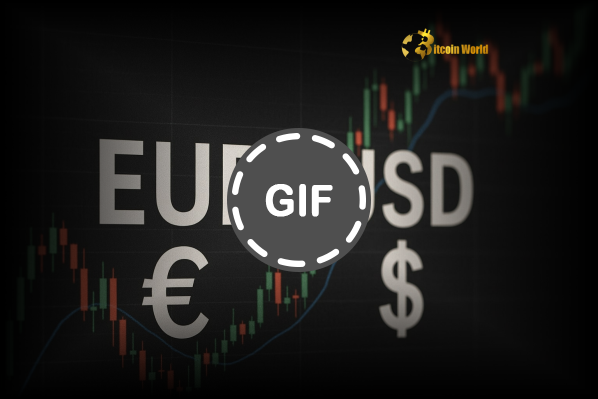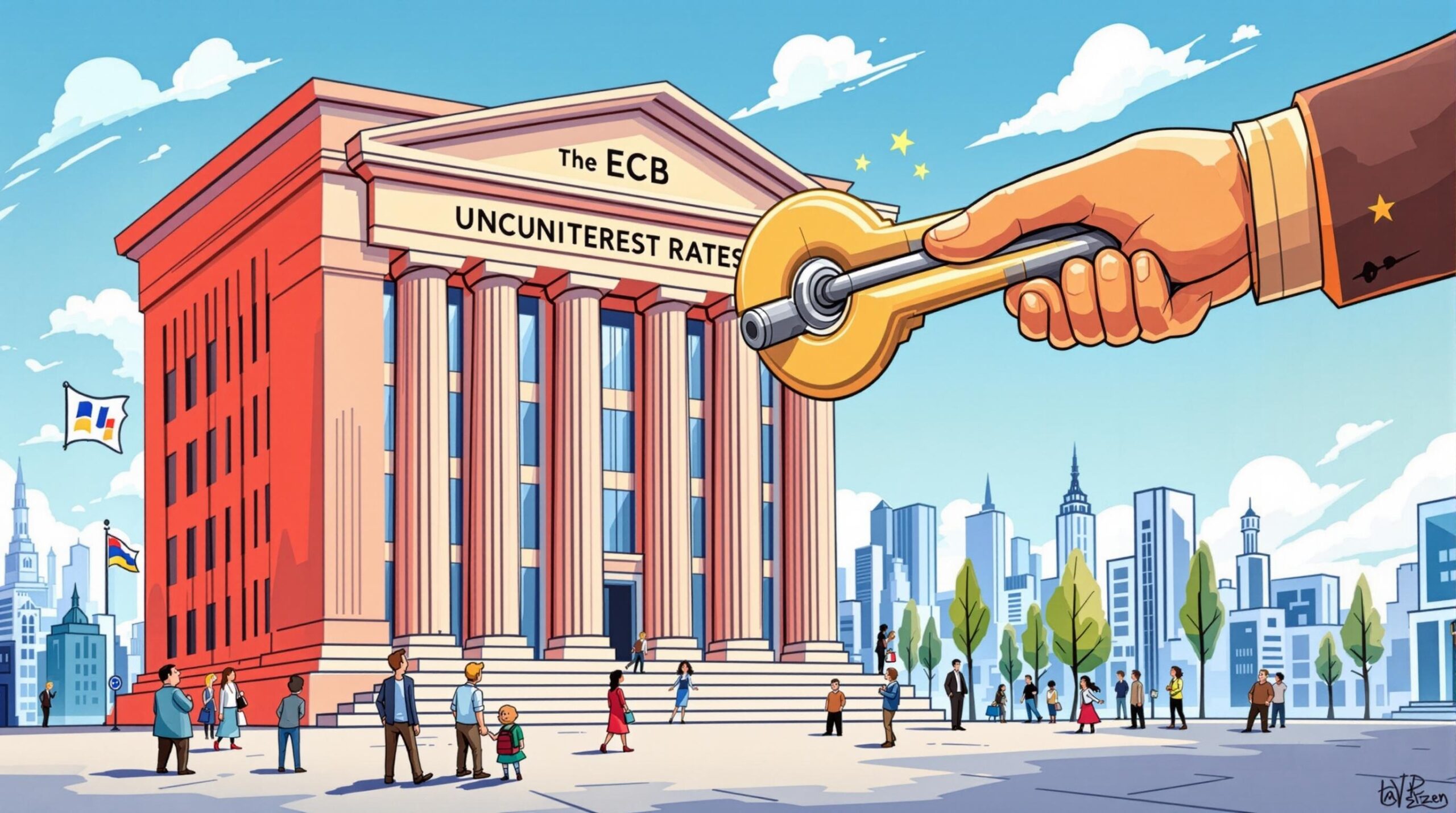BitcoinWorld

EUR/USD Alert: Critical Divergence Points to Potential Gains
For those navigating the complex landscape of financial markets, particularly the Forex Market and its intersection with digital assets, understanding major currency pairs like EUR/USD is crucial. The exchange rate between the Euro and the US Dollar is a cornerstone of global finance, influenced profoundly by the monetary policies of the two most powerful central banks: the European Central Bank (ECB) and the U.S. Federal Reserve. Recent signals from these institutions suggest their paths regarding Interest Rates are set to diverge, a development that could significantly impact the EUR/USD pair and send ripples through the broader financial ecosystem.
Understanding the Critical Role of Interest Rates in the Forex Market
At its core, the value of one currency relative to another is driven by a multitude of factors, but Interest Rates stand out as a primary determinant. Higher interest rates in a country tend to attract foreign investment seeking better returns, increasing demand for that country’s currency. Conversely, lower rates can make a currency less attractive, potentially leading to capital outflows.
Central banks like the ECB and the Federal Reserve use interest rates as their main tool to manage inflation and economic growth. When they adjust these rates, they signal their economic outlook and policy intentions, which currency traders and investors closely watch. A divergence in their approaches – one central bank signaling cuts while the other holds steady or hints at slower cuts – creates a differential that can significantly influence currency valuations. For the EUR/USD pair, this means that if the Federal Reserve maintains higher rates relative to the ECB, the US Dollar might strengthen against the Euro, and vice versa.
However, the relationship is not always straightforward. Market expectations, future projections, and other economic indicators play equally vital roles in how currency pairs react to central bank actions and forward guidance. The current scenario points towards a potential divergence that market participants believe could favor gains for the EUR/USD pair, suggesting nuances beyond a simple rate differential are at play.
The European Central Bank’s Position: Leaning Towards Easing?
The ECB has been grappling with inflation across the Eurozone, which surged significantly in recent years. While inflation has shown signs of moderating, bringing it back to the ECB‘s target remains a key focus. Recent commentary from ECB officials has increasingly hinted at the possibility of rate cuts in the near future, potentially sooner than previously anticipated by some analysts.
Several factors contribute to this stance:
- Falling Inflation: Headline and core inflation metrics have been trending downwards, suggesting that previous rate hikes are having the desired effect on price pressures.
- Economic Growth Concerns: The Eurozone economy has shown signs of sluggishness, with some member states facing technical recessions. Rate cuts could provide stimulus to support growth.
- Wage Moderation: While wage growth was a concern, recent data suggests it might be moderating, reducing fears of a wage-price spiral.
- Forward Guidance: Key ECB policymakers have publicly discussed the conditions under which rate cuts would be appropriate, setting the stage for potential action.
The market is now pricing in a significant probability of an ECB rate cut relatively soon. This expectation of lower Interest Rates in the Eurozone would typically weigh on the Euro’s value. However, the context of the divergence with the Federal Reserve is critical to understanding the potential for EUR/USD gains.
The Federal Reserve’s Stance: Patience is the Watchword
Across the Atlantic, the Federal Reserve faces a different economic picture. The U.S. economy has demonstrated remarkable resilience, particularly the labor market, which remains robust. While U.S. inflation has also eased from its peaks, it has proven stickier than in the Eurozone, particularly in the services sector.
The Federal Reserve‘s communication has been cautious. While they acknowledge progress on inflation, they have emphasized the need for more data to be confident that inflation is sustainably moving towards their 2% target. Key aspects of the Fed’s position include:
- Strong Labor Market: Low unemployment and solid wage growth provide less urgency for immediate rate cuts compared to economies facing labor market weakness.
- Persistent Inflation: While lower, inflation remains above the Fed’s target, and policymakers are wary of cutting rates too soon, which could risk reigniting price pressures.
- Data Dependence: The Fed has repeatedly stated its decisions will be data-dependent, meaning upcoming inflation and employment reports will heavily influence their timing.
- Higher for Longer Rhetoric: Some Fed officials have maintained a hawkish stance, suggesting rates may need to stay elevated for longer than the market initially expected.
Compared to the ECB, the Federal Reserve appears to be on a slower, more cautious path towards lowering Interest Rates. The market’s expectations for Fed rate cuts have been pushed back, reflecting this patient approach. This relative difference in expected policy trajectories is the core of the divergence impacting the EUR/USD.
Why Divergence Might Fuel EUR/USD Gains
The title suggests that the divergence itself is a catalyst for EUR/USD gains. This might seem counter-intuitive if the ECB is expected to cut rates while the Fed holds. However, the market is forward-looking, and current pricing reflects expectations. The key lies in how this specific divergence compares to prior expectations and how other factors interact.
Here’s a breakdown of potential reasons why this divergence scenario could support EUR/USD gains:
1. Relative Pace of Cuts: While the ECB might cut first, the market could be anticipating that the Federal Reserve, once it starts, might undertake a more aggressive series of cuts due to underlying vulnerabilities in the U.S. economy not immediately apparent in headline data. If the expected total quantum of Fed cuts eventually surpasses that of the ECB, it could lead to a narrowing or even reversal of rate differentials further down the line, supporting EUR.
2. ‘Dovish’ Fed Repricing: If the market was previously positioned for more aggressive Fed cuts that haven’t materialized, the current ‘higher for longer’ stance strengthens the Dollar relative to those prior expectations. However, if the narrative shifts towards the Fed being closer to cuts than recent hawkish talk suggests, or if fears of a US slowdown grow, this could weaken the Dollar, boosting EUR/USD.
3. Eurozone Resilience Surprises: While the Eurozone economy has been weak, any signs of unexpected resilience or improvement could lead to a repricing of ECB rate cut expectations – perhaps fewer cuts than currently priced. If the Eurozone outlook improves relative to a potentially slowing U.S. economy, it supports the Euro.
4. Global Risk Sentiment: The Euro often acts as a funding currency in risk-on environments. If global economic prospects brighten or market volatility decreases, investors may be more willing to take on risk, potentially increasing demand for the Euro and boosting EUR/USD.
5. Technical Factors and Positioning: Large speculative positions in the Forex Market can influence price movements. If there was a crowded trade betting heavily against the Euro based on expected ECB dovishness, any slight shift in the narrative or minor positive data could trigger a short squeeze, driving EUR/USD higher.
It’s this interplay of relative expectations, economic outlooks, and market positioning that can lead to a seemingly counter-intuitive outcome where expected central bank divergence results in gains for the currency of the central bank expected to cut sooner.
Beyond Interest Rates: Other Drivers for EUR/USD
While central bank policies are paramount, several other factors significantly influence the EUR/USD exchange rate in the Forex Market:
Relative Economic Growth: Differences in GDP growth rates between the Eurozone and the U.S. can impact currency strength. Stronger growth typically attracts investment.
Inflation Differentials: While central banks target inflation, persistent differences in inflation rates between the two regions can affect purchasing power and currency values.
Political Stability and Geopolitical Events: Major political developments or conflicts (like the war in Ukraine or tensions elsewhere) can increase uncertainty, leading investors towards perceived safe havens like the U.S. Dollar, or away from currencies seen as more exposed, like the Euro.
Fiscal Policy: Government spending and taxation policies can impact economic health and debt levels, influencing currency attractiveness.
Trade Balances: Large trade surpluses or deficits can affect the supply and demand for a currency.
Market Sentiment: Overall risk appetite or aversion in global markets plays a role. During periods of high uncertainty, the Dollar often benefits from its safe-haven status.
Understanding the confluence of these factors alongside the central bank divergence is essential for a comprehensive view of EUR/USD prospects.
Comparing ECB and Federal Reserve Policy Trajectories
To visualize the expected divergence, consider the market’s current broad expectations, though these are subject to change based on incoming data:
| Factor | European Central Bank (ECB) | Federal Reserve (Federal Reserve) |
|---|---|---|
| Current Stance | Holding rates, signaling potential cuts soon | Holding rates, patient approach |
| Inflation Trend | Moderating more rapidly | Slower moderation, stickier services inflation |
| Economic Growth | Sluggish, some recession concerns | Resilient, strong labor market |
| Likelihood of Near-Term Cut (e.g., next 1-3 months) | Higher Probability | Lower Probability |
| Expected Pace of Cuts (Over next year, market view) | Moderate pace, potentially front-loaded | Potentially slower start, but total cuts could be significant if economy weakens |
| Primary Focus | Balancing inflation control and growth support | Ensuring inflation returns sustainably to 2% |
This table highlights the expected difference in timing and emphasis, creating the divergence that is central to the EUR/USD outlook. The market is constantly adjusting its expectations based on new data and central bank commentary, making the Forex Market dynamic and requiring continuous analysis.
Historical Perspective: Divergence in Action
Looking back, periods where the ECB and the Federal Reserve were on significantly different policy paths have historically led to notable movements in the EUR/USD pair. For instance, when the Fed was aggressively hiking rates while the ECB was still maintaining a more accommodative stance, the Dollar tended to strengthen considerably against the Euro. Conversely, periods where the ECB was tightening while the Fed was easing saw the Euro gain ground.
However, past performance is not indicative of future results. Each period of divergence occurs within a unique economic and geopolitical context. The current situation is influenced by post-pandemic recovery dynamics, supply chain adjustments, energy price volatility, and shifts in global trade relationships, all of which add layers of complexity to the traditional relationship between rate differentials and currency movements.
Challenges and Uncertainties on the Path Ahead
While the narrative of divergence supporting EUR/USD gains is gaining traction, significant uncertainties remain. The path of Interest Rates for both the ECB and the Federal Reserve is not set in stone. Their decisions will depend heavily on incoming economic data, which can be volatile and subject to revision.
Key challenges include:
- Inflation Persistence: If inflation proves more stubborn than expected in either the Eurozone or the U.S., it could force central banks to revise their plans, potentially delaying or altering the pace of rate cuts.
- Economic Shocks: Unexpected events, such as a sharp slowdown in global growth, a new energy crisis, or an escalation of geopolitical tensions, could drastically alter the economic outlook and central bank responses.
- Central Bank Communication: Mixed or unclear signals from policymakers can lead to market confusion and volatility, making it difficult to anticipate moves in the Forex Market.
- Fiscal Policy Interactions: The impact of government spending and debt levels in both regions can influence central bank decisions and currency valuations in ways that are not always predictable.
- Market Positioning: As mentioned, crowded trades can lead to sharp reversals if the market narrative shifts, adding a layer of risk for traders betting on a specific direction for EUR/USD.
Navigating the Forex Market under these conditions requires careful monitoring of economic indicators and central bank statements, as well as a robust risk management strategy.
Actionable Insights for Market Participants
For those trading or investing with exposure to the EUR/USD pair, understanding the implications of this potential divergence is key. Here are some actionable insights:
- Monitor Key Data Releases: Pay close attention to inflation reports (CPI, PCE), employment data (Non-Farm Payrolls, Eurozone unemployment), GDP growth figures, and retail sales from both the Eurozone and the U.S. These will heavily influence central bank decisions on Interest Rates.
- Analyze Central Bank Commentary: Speeches, press conferences, and meeting minutes from the ECB and the Federal Reserve provide valuable clues about their thinking and future intentions. Look for shifts in language regarding inflation risks, growth outlook, and the timing of potential rate adjustments.
- Understand Market Expectations: Follow how the market is pricing in future rate moves using tools like Fed Funds Futures and Euro Short-Term Rate (ESTR) forwards. Divergences between market expectations and central bank communication often create volatility and trading opportunities.
- Consider Relative Economic Strength: Evaluate the economic health of the Eurozone relative to the U.S. Are there signs of the Eurozone economy picking up, or the U.S. economy slowing down? This relative performance can impact currency flows.
- Factor in Global Risk: Assess the prevailing global risk sentiment. Is it a risk-on or risk-off environment? This can influence demand for safe-haven currencies like the U.S. Dollar.
- Utilize Technical Analysis: While fundamentals are crucial, technical analysis can help identify potential entry and exit points, support and resistance levels, and trend strength for the EUR/USD pair in the Forex Market.
- Practice Risk Management: Given the potential for volatility, employing sound risk management techniques, such as setting stop-loss orders and managing position sizes, is essential.
Approaching the Forex Market with a well-informed perspective on the fundamental drivers, particularly central bank policies and economic data, can help market participants navigate the opportunities and risks presented by the evolving EUR/USD landscape.
Conclusion: Navigating the EUR/USD Outlook
The EUR/USD pair finds itself at a critical juncture, heavily influenced by the anticipated divergence in monetary policy between the ECB and the Federal Reserve. While a simpler interpretation might suggest that the central bank cutting rates first would weaken its currency, the complex interplay of market expectations, relative economic performance, and other global factors suggests that this specific divergence scenario could indeed pave the way for potential gains for the EUR/USD pair.
The ECB appears closer to initiating rate cuts, driven by moderating inflation and growth concerns in the Eurozone. The Federal Reserve, conversely, maintains a more patient stance, prioritizing the sustainable return of inflation to target amidst a resilient U.S. economy. This difference in pace and priority creates the policy divergence that is now a central theme in the Forex Market.
However, the path forward is fraught with uncertainty. The actual timing and magnitude of Interest Rates adjustments by both central banks will depend on incoming data. Furthermore, geopolitical developments, shifts in market sentiment, and unforeseen economic shocks could quickly alter the trajectory of the EUR/USD pair. For market participants, staying informed about central bank communications, key economic indicators, and the broader macro environment is paramount to understanding and potentially capitalizing on the evolving dynamics of this crucial currency pair.
To learn more about the latest Forex market trends, explore our article on key developments shaping interest rates and currency pairs.
This post EUR/USD Alert: Critical Divergence Points to Potential Gains first appeared on BitcoinWorld and is written by Editorial Team





